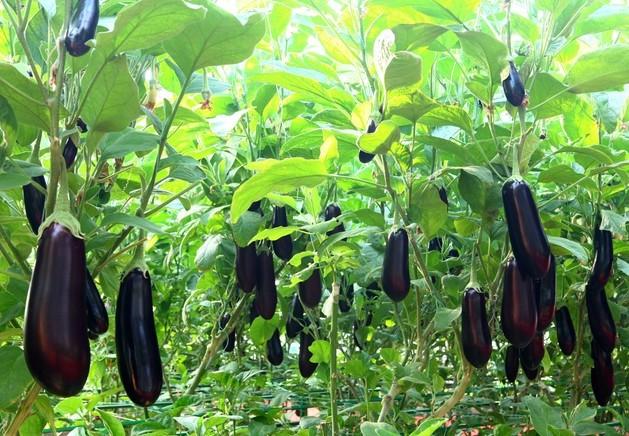Fertilization Management of Eggplant in Open Field
VIEWS: times Release Date:2021-03-12

01 Nursery stage management
The management of heat preservation and moisture preservation is an important measure for the management of the seedling stage.
1. The suitable temperature of the seedbed is 25~30℃, and the ground temperature is 16~22℃;
2. Ensure that after the whole seedlings emerge, the temperature during the day does not exceed 24℃, and the temperature at night is not lower than 15℃.
3. One week before planting, control the uniformity and stability of the temperature.
During the low-temperature smelting stage, increase the amount of ventilation, no more than 20℃ during the day and no less than 10℃ at night.
02 Planting field management
Planting as early as possible in spring, generally requires a stable temperature of 15 ℃, and spray carbendazim solution before transplanting seedlings. In order to ensure the survival rate of transplanting, it is necessary to prepare the ground before planting. Eggplants are most afraid of repeated stubble. The soil planting area that has not been planted solanaceous crops is the first choice. The soil quality is the upper part and the lower part.
Water and fertilizer management
After the completion of planting, the eggplant needs to be managed with water and fertilizer to ensure sufficient soil moisture and nutrients. Usually, after the slow seedling period, weeding and weeding are used for the first topdressing, and MAINPAR (20-5-7) compound fertilizer can be used. Add secondary fertilizer and water one month after flowering, ensure adequate irrigation during top dressing, control the moist degree of eggplant vegetation in the field, avoid excessive humidity causing eggplant infections, and pay attention to field ventilation after irrigation.
Pruning, picking leaves
After the formation of Mentha, the leaves can be picked by double-stem pruning, the outer extension branches and leaves are cut off in time, the main stem is retained, and the plants that grow to the seventh fruit are topped. The harvesting period of eggplant can be prolonged by pruning with regeneration technology, and 3 root basal leaves during the fruit-setting period of Menganja can be removed. Combined with the growth and development of the plant, the bottom leaves are removed in time to promote the integrity of the plant's ventilation and light transmission, accelerate plant growth, and expand the harvest stage.
Field management
In order to effectively increase the growth rate of eggplants, scientific and strict fertilizer and water management are required. Make sure to control first and then promote watering. Carry out planting water and slow seedling water watering before flowering. At other times, pay attention to the fact that eggplants are not tolerant to waterlogging and are not easy to water more. In the rainy season, attention should be paid to strengthening the field drainage. When there is a thunderstorm, it is necessary to timely drain and lower the soil temperature to ensure proper water content and enhance the soil nutrients of the vegetation.
03 Prevention and control of common pests and diseases
During the eggplant planting process, it is extremely vulnerable to plant diseases and insect pests to reduce production, which severely restricts the commercial value of eggplants and reduces the economic benefits of farmers. In this regard, the management of diseases and insect pests should be strengthened, and the diseases and insect pests that eggplants are susceptible to infection should be treated and prevented. Common pests include red spiders and aphids. To prevent red spiders, it is necessary to ensure that the planting soil has sufficient moisture and proper humidity, and clean the fallen leaves of eggplants in time to prevent hiding the source of insects. Common epidemic diseases include: eggplant damping-off, verticillium wilt, gray mold and so on. Among them, Verticillium wilt is transmitted by soil, and the diseased leaves turn from yellow to brown. It can be treated by spraying medicine, spraying 2 to 3 times a week. In addition, a proportion of the spraying of Sukeling protective liquid is used to remove gray mold.
Previous : NPK 23:10:5 +6S +1Zn granular compound fertilizer
Next : Introduction of high end compound fertilizer brand of Huaqiang Chemical Group
Latest News
- The company overcame difficulties and won a "good start" in the first quarter ...2022-03-28
- Safe Production ...2022-03-28
- first-line collection ...2022-03-26
- Huaqiang News ...2022-03-26
- Huaqiang Chemical Strong Agriculture Project ...2022-03-25
- huaqiang news ...2022-03-24
- winning unit ...2022-03-22
- Huaqiang News ...2022-03-21
Related Information
- The best fertilizers for fruits and crops ...2020-05-26
- Huaqiang Chemical Group NPK fertilizer pdf ...2020-04-01
- Humic Acid Fertilizer ...2019-12-31
- Bulk Blending Fertilizer ...2019-12-27
- Water Soluble Fertilizer ...2019-12-08
- NPK Fertilizer ...2019-12-02
- Potassium Sulfate Fertilizer ...2019-11-30
- Urea Fertilizer ...2019-11-21
MESSAGE
Our sales staff will be the first time to get in touch with you,to provide you with the latest price.
-
Chemical Products
-
Compound fertilizer
-
Contact Us
Huaqiang Chemical Group Stock Co.,Ltd.
No.1 Jinping Avenue, Dangyang , Hubei , China
Http://www.hq-chemical.com
info@hq-chemical.com
Tel:+86 717 3431866
Mobile: +86 18627120543
© Copyright 2021 Huaqiang Chemical Group Stock Co.,Ltd. All Rights Reserved



